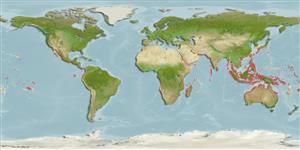Common names from other countries
Environment: milieu / climate zone / depth range / distribution range
Ecologia
marino; acqua dolce; salmastro benthopelagico; amfidromo (Ref. 51243); distribuzione batimetrica 0 - 3 m (Ref. 86942). Tropical; 22°C - 28°C (Ref. 13614)
Indo-Pacific: south to East London, South Africa (Ref. 2798). Western Central Pacific: Guam (Ref. 35720). Often confused with the more common Glossogobius giuris.
Size / Peso / Age
Maturity: Lm ? range ? - ? cm
Max length : 19.8 cm TL maschio/sesso non determinato; (Ref. 108711)
Spine dorsali (totale): 7; Raggi dorsali molli (totale): 9; Spine anali 1; Raggi anali molli: 8. Body dark brown to black, with longitudinal rows of small black spot; 2-3 saddles on back and side; black 1st dorsal fin; dark crossbands on pelvic fins (Ref. 2798).
Inhabits intertidal areas, estuaries, lagoons and coastal rivers. Common in mangroves (Ref. 4343, 44894). Occasionally penetrates the lower reaches of freshwater streams (Ref. 44894).
Life cycle and mating behavior
Maturità | Riproduzione | Deposizione | Uova | Fecundity | Larve
Maugé, L.A., 1986. Gobiidae. p. 358-388. In J. Daget, J.-P. Gosse and D.F.E. Thys van den Audenaerde (eds.) Check-list of the freshwater fishes of Africa (CLOFFA). ISNB, Brussels; MRAC, Tervuren; and ORSTOM, Paris. Vol. 2. (Ref. 4343)
IUCN Red List Status (Ref. 130435)
CITES (Ref. 128078)
Not Evaluated
Threat to humans
Harmless
Human uses
Pesca: di nessun interesse
Informazioni ulteriori
Nomi ComuniSinonimiMetabolismoPredatoriEcotossicologiaRiproduzioneMaturitàDeposizioneFecundityUovaEgg development
BibliografiaAcquacolturaProfilo di acquacolturaVarietàGeneticaElectrophoresesEreditarietàMalattieElaborazioneMass conversion
Strumenti
Special reports
Download XML
Fonti Internet
Estimates based on models
Preferred temperature (Ref.
115969): 24.2 - 29.3, mean 28.4 (based on 2860 cells).
Phylogenetic diversity index (Ref.
82804): PD
50 = 0.6250 [Uniqueness, from 0.5 = low to 2.0 = high].
Bayesian length-weight: a=0.01047 (0.00632 - 0.01736), b=3.04 (2.90 - 3.18), in cm Total Length, based on LWR estimates for this species & (Sub)family-body (Ref.
93245).
Trophic level (Ref.
69278): 3.5 ±0.4 se; based on size and trophs of closest relatives
Resilienza (Ref.
120179): Medio, tempo minimo di raddoppiamento della popolazione 1.4 - 4.4 anni (Preliminary K or Fecundity.).
Fishing Vulnerability (Ref.
59153): Low vulnerability (10 of 100).
